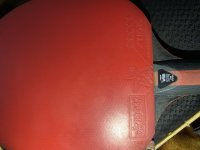This user has no status.
This user has no status.
Member
It is a commonly use strategy to hit harder because forehand inherently hit harder, add deception on placement and cover a weak backhand due to bad technique of the backhand. What I don't understand is that why is stepping around an exclusive thing for forehand?
Now, assume that your forehand and backhand are equal in terms of technique (timing, accuracy, consistency etc.). It makes sense to do a forehand-step-around (step around to attack with forehand on the backhand side) during a backhand corner to corner rally but do you ever see people do a backhand-step-around during a forehand rally? If there is any video, please let me know.
I don't think I see a lot of that. I mean, sure there is no increase in power like a forehand-step-around can give you but the added advantage of increased attacking angle remains and your next line of attack is less obvious. Plus, you can always add side spin to it with backhand in side out or back hand hooking loop to widen the angle. However, if you try to change the angle by attacking down the line or even bend it with forehand inside out during a forehand corner to corner rally, you may not be able to create an wide of as angle and it is extremely obvious.
I can see some advantage with a backhand step around. What do you think?
(oops. it is the equipment section sorry)
sorry)
Now, assume that your forehand and backhand are equal in terms of technique (timing, accuracy, consistency etc.). It makes sense to do a forehand-step-around (step around to attack with forehand on the backhand side) during a backhand corner to corner rally but do you ever see people do a backhand-step-around during a forehand rally? If there is any video, please let me know.
I don't think I see a lot of that. I mean, sure there is no increase in power like a forehand-step-around can give you but the added advantage of increased attacking angle remains and your next line of attack is less obvious. Plus, you can always add side spin to it with backhand in side out or back hand hooking loop to widen the angle. However, if you try to change the angle by attacking down the line or even bend it with forehand inside out during a forehand corner to corner rally, you may not be able to create an wide of as angle and it is extremely obvious.
I can see some advantage with a backhand step around. What do you think?
(oops. it is the equipment section
Last edited:











